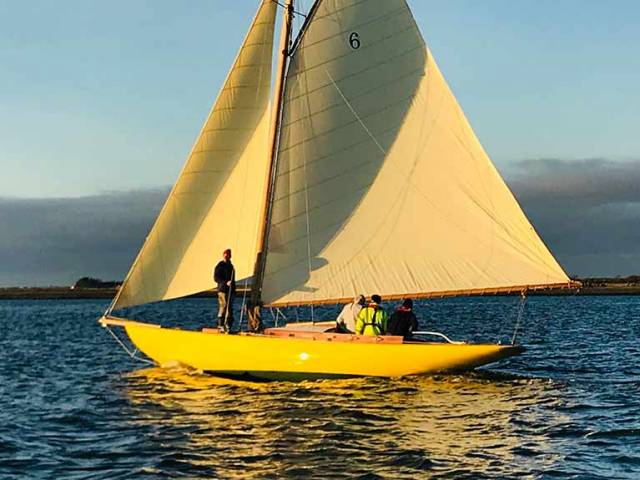Sunshine in December imparts a surreal look to everything it illuminates with its vivid low-angled delineation. And for anyone who happened to be on the Shannon Estuary between Kilrush and Scattery Island on Monday afternoon this week, the sense of mythology realised was accentuated by the very welcome sunlight gleaming on the elegant hull and sweet-setting vintage rig of the re-born 1905-built Dublin Bay 21 Naneen, sailing for the first time in thirty-three years.
It was back in September that we witnessed the launching of Naneen after the completion of the meticulously crafted re-creation of the hull, deck and cabin-roof of the Alfred Mylne-designed classic by Steve Morris and his team at Kilrush Boatyard. But while this certainly looked very much like the able and beautiful boat that she undoubtedly is, much still needed to be done in the detailed installation of fittings and other equipment to accommodate the simpler rig which Fionan de Barra and Hal Sisk’s Dublin Bay 21 Restoration Project is using to make these special boats more accessible and manageable in their home waters at Dun Laoghaire.
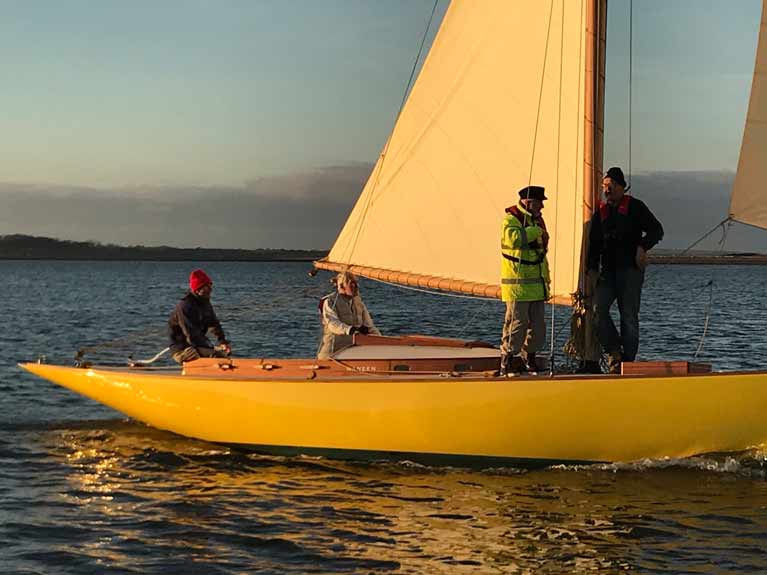 A successful Alfred Mylne design combines overall elegance with exquisite detail. The stylish cabin (which Mylne referred to as “The Den”) is a little masterpiece of coachroof design. Standing by the mast facing forward in a state of enchantment is Fionan de Barra – he sailed on Naneen in 1968 when she was owned by Willie Maguire. Photo: Kate Griffiths
A successful Alfred Mylne design combines overall elegance with exquisite detail. The stylish cabin (which Mylne referred to as “The Den”) is a little masterpiece of coachroof design. Standing by the mast facing forward in a state of enchantment is Fionan de Barra – he sailed on Naneen in 1968 when she was owned by Willie Maguire. Photo: Kate Griffiths
Getting everything just right for Naneen’s first sail began to seem like one of those projects which feel as though they’re moving ever more slowly the nearer everything gets to the final objective, particularly in the fulfilling of very special requirements for the classic-style sails Yet there was something in the air last weekend which hinted at a fair wind for all classic boat enthusiasts in Ireland, and the first sail of the Naneen on Monday was the ultimate expression of it all.
For on Saturday night, the Howth 17s had held their annual dinner and prize-giving, an event which first began 122 years ago. But 2019’s gathering – hosted by Class Captain Susan Morgan – was very special, as it celebrated the completed restoration of the class to its current full complement of 19 boats after a quarter of the fleet was variously damaged – one becoming a complete write-off – when their winter storage shed on Howth’s East Pier had its roof demolished by Storm Emma on 2nd March 2018.
But now the class is back in full health, 54 races were completed during 2019, and though the top scratch performers were Deilginis (Massey, Twomey and Kenny) and Rita (John Curley & Marcus Lynch), the class’s sensible handicap system ensures that most boats are among the silverware.
A sense of the decidedly manic mood and enhanced spirit of community which saved the Seventeens is captured in this vid by Assistant Class Captain David O’Shea
Getting the Seventeens restored to full strength has been a massive effort involving many people, and widespread and diverse craftsmen. But with a strong and supportive class organisation and several generous benefactors, it was a reasonably manageable project by comparison with the challenge of reviving the Dublin Bay 21s.
The DB21 class first raced in June 1903, with five boats competing in that opening season. Naneen didn’t appear until 1905, but she was special, as she was one of the few actually built in what was then Kingstown. Her builder was James Clancy, and the class reached what was reckoned the ideal number of seven boats with the addition of Geraldine in 1908.
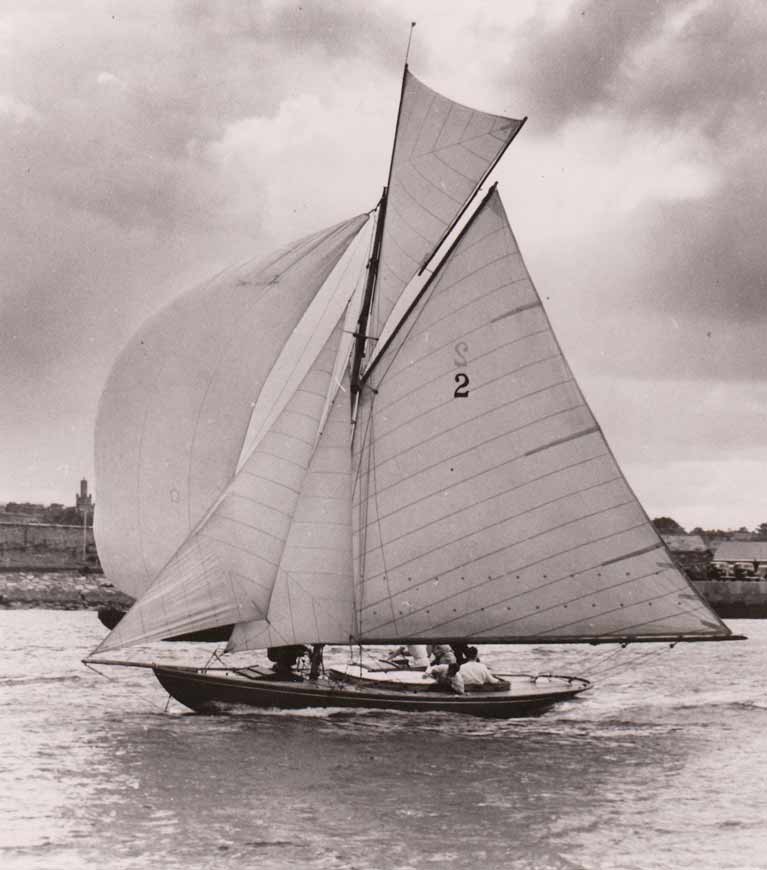 “You couldn’t see the boat for the acres of sail”. Under their original rig which they carried for fifty years, the Dublin Bay 21s were always a challenging proposition to race hard.
“You couldn’t see the boat for the acres of sail”. Under their original rig which they carried for fifty years, the Dublin Bay 21s were always a challenging proposition to race hard.
Setting a widow-making labour-intensive gaff cutter rig with a large jackyard topsail, the class became a by-word for hard-driving racing, such that by the early 1960s the hulls were becoming very tired. And crews were increasingly difficult to recruit as more easily-sailed boats in the new-fangled low-maintenance glassfibre construction came on the market.
So in 1964 the class changed to a much simpler Bermudan masthead rig. And though some reckoned the introduction of a standing backstay which was tensioned by a wheel-turned rigging screw was something which hastened the final exhaustion of the hulls, the new setup provided the class with another 22 seasons of racing.
Admittedly some of the boats were very tired indeed when Hurricane Charlie delivered the final coup de grace in Dun Laoghaire in August 1986. In those pre-marina days, the harbour became a total maelstrom, and when it finally emerged after the onshore storm feeling very bruised and battered, there wasn’t a remotely seaworthy Dublin Bay 21 left.
Most Dun Laoghaire sailors were resigned to the class’s demise, but architect Fionan de Barra was so much of a Dublin Bay 21 enthusiast that he wouldn’t hear of such a thing. Gradually he acquired the rights to all that remained of the seven 21s - whose beauty still shone through their various levels of damage – and after some time in storage in Arklow, they found a longterm home in a Wicklow farmyard while Fionan cast about for ways and means of giving them a new life.
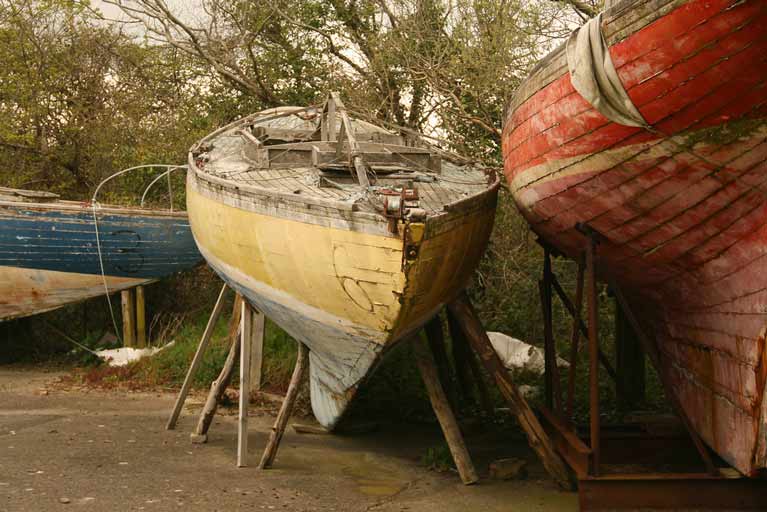 The de-commissioned Naneen with two of her sisters in a Wicklow farmyard, awaiting a restoration plan
The de-commissioned Naneen with two of her sisters in a Wicklow farmyard, awaiting a restoration plan
He’d given himself a herculean task. And when we realize that he recently celebrated his 80th birthday, we can get some notion of how he felt sailing for the first time aboard the re-born Naneen in those sublime conditions on Monday, the extraordinary achievement of his life’s most cherished dream after 33 years.
It was linking-up with Hal Sisk some years ago that really began to put the project into the realms of possibility. Hal is a veritable universe of classic yacht and boat restoration. His best-known project is the painstaking and very deservedly award-winning restoration of the 1894 G L Watson-designed 36ft cutter Peggy Bawn, which was undertaken by Michael Kennedy of Dunmore East with a small team of specialists between 2003-2005.
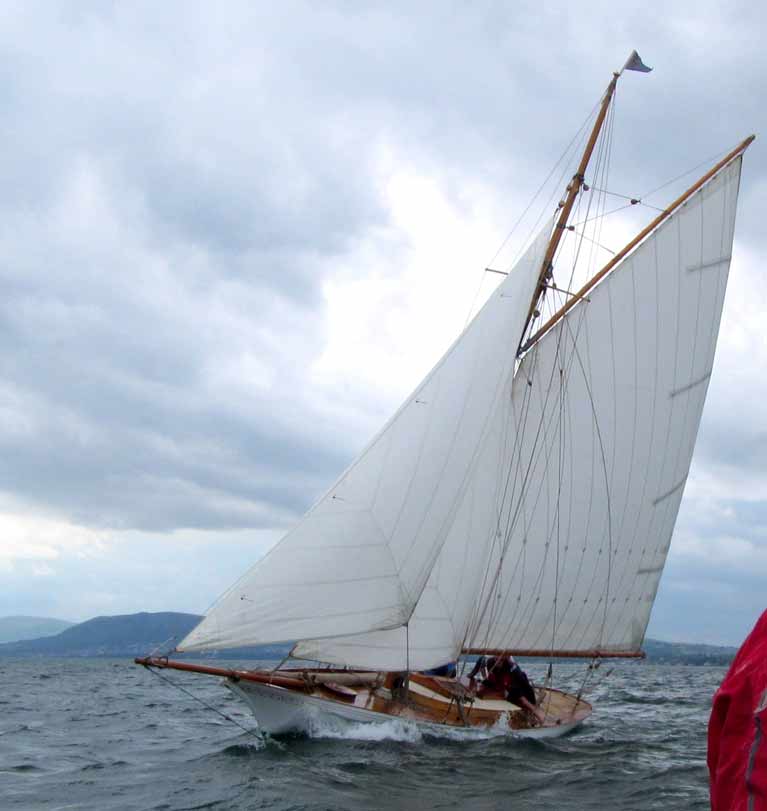 The immaculately restored G L Watson cutter Peggy Bawn sailing in Belfast Lough off Carrickfergus, where she was built by John HIlditch in 1894. Photo: Trish Nixon
The immaculately restored G L Watson cutter Peggy Bawn sailing in Belfast Lough off Carrickfergus, where she was built by John HIlditch in 1894. Photo: Trish Nixon
But before that, Hal had been a pioneer in Ireland with his restoration in 1984 of the 1884-built miniature Fife plank-on-edge cutter Vagrant. And while he has adhered to the original concept in having a new Dublin Bay Water Wag built, equally he has thought outside the box with a glassfibre version of the old Dublin Bay Colleens, which were once so popular there was an offshoot class in Argentina.
Thus Hal and Fionan began to develop ideas which retained the spirit of the class while making the boats more appropriate to the needs of today in Dun Laoghaire harbour, with its many other rival sailing attraction. They reckoned that retaining the pure Mylne-designed hull was essential, but that a simpler yet clearly vintage rig was needed for the time-constrained sailors of the 21st Century.
In the early stages of developing their thinking, they were able to draw on the fertile mind of naval architect and yacht design historian Theo Rye, who contributed so much to the Irish classic and traditional boat movement.
 Hal Sisk and the late Theo Rye in Limerick in 2014 for the first launching of the innovative CityOne sailing dinghies (in background) which Theo designed for Gary Mac Mahon and the Ilen Boat-Building School. Photo: W M Nixon
Hal Sisk and the late Theo Rye in Limerick in 2014 for the first launching of the innovative CityOne sailing dinghies (in background) which Theo designed for Gary Mac Mahon and the Ilen Boat-Building School. Photo: W M Nixon
But very sadly he was taken from among us with his untimely death aged only 48 in 2016. The essential role of technical consultant was in due course taken on by Paul Spooner, who fully understood Hal and Fionan’s aspirations towards finding an acceptable balance between the Dublin Bay 21s’ history, and the demands of the modern sailing scene. After further research and more than a few brainstorming sessions, a plan emerged to have new timber hulls built on the original lead ballast keels – thereby continuing the direct historical line of each individual boat – but it was decided the actual boat-building would use modern wood construction technology.
Finding the appropriate specialist boatyards suitable for the task was a search in itself, and for one of the hulls, they went to England and the renowned Elephant Boatyard on the upper reaches of the River Hamble off the Solent. But for Naneen – rather special with her all-Dun Laoghaire origins – they went to Steve Morris of Kilrush Boatyard in far West Clare on the Shannon Estuary.
 The characterful traditional Shannon cutter Sally O’Keeffe is one of Steve Morris’s best-known boat-building project
The characterful traditional Shannon cutter Sally O’Keeffe is one of Steve Morris’s best-known boat-building project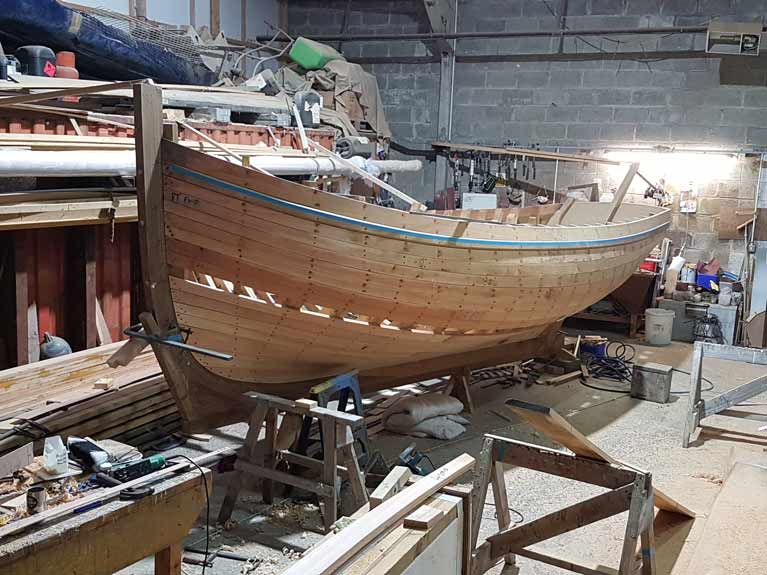 While work is continuing on two more Dublin Bay 21s in Kilrush, in another part of the big shed Steve Morris and his team are deploying more traditional boat-building skills to create this new Galway Bay gleiteog. Photo: Steve Morris
While work is continuing on two more Dublin Bay 21s in Kilrush, in another part of the big shed Steve Morris and his team are deploying more traditional boat-building skills to create this new Galway Bay gleiteog. Photo: Steve Morris
Anything that Steve Morris and his growing team undertake seems special in the quality of its workmanship, and the affable New Zealander’s abilities cover the broadest possible spectrum. Until Naneen came along, he was best known as the lead teacher-builder in the Querrin community’s creation of the Sally O’Keeffe, the utterly charming yet extremely effective re-creation of a traditional Shannon Estuary sailing working boat.
But while Sally O’Keeffe was built in the time-honoured simple planked wooden construction style, Steve has shown himself equally adept in working with the most modern materials, and the re-building of the Naneen to very clearcut standards and design requirements was a challenge he relished.
The hull was built upside-down using the SP Systems epoxy method. The main skin is 16mm yellow cedar t&g strip with two African mahogany quarter-sawn veneers on laminated African mahogany frames and ribs, with the original Alfred Mylne framing schedule being strictly followed. The entire centre-line is laminated iroko. As for the deck, in keeping with the original value concept, it is two layers of Robbins Elite marine ply on Douglas fir beams and carlins. When completed, both hull and deck were sheathed with two layers of 280 gram twill weave cloth set in epoxy.
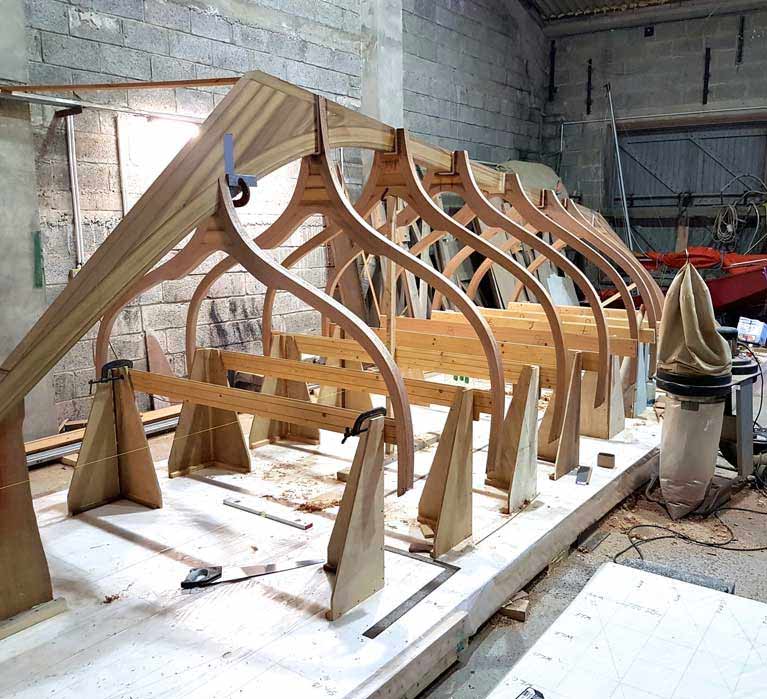 An early stage of the Naneen re-build, with the laminated African mahogany frames hinting at the classically beautiful hull which will be the finished product. Photo: Steve Morris
An early stage of the Naneen re-build, with the laminated African mahogany frames hinting at the classically beautiful hull which will be the finished product. Photo: Steve Morris
Clearly, with construction of this quality, the re-born Dublin Bay 21s are going to be in prime condition for a very long time. So it’s in line with this philosophy of the long view that the appropriate time was allocated to making the completed boat into a sailing proposition. But with a miserably wet and dark November veering inevitably into December, suddenly the weather lightened and the pace quickened, and an urgently exuberant missive from Hal this week captures the flavour of Monday’s extraordinary experience:
“We may not get such a perfect weather window before Christmas. And Naneen’s first sail was magnificent, despite being straight out of the box.
The large package with the special sails arrived by courier at home in Dun Laoghaire on Friday at 17.00, but I couldn’t get down to Kilrush until Sunday at 12 on Sunday, with three hours spent bending on the sails in a sunny calm. Then Fionán arrived down in the dark, and we stayed aboard Molly Bán (Hal’s purpose-designed motor cruiser and mothership).
Next morning, cold and clear - we’d to wait until 10.30 to even walk on the very icy marina pontoon, while Naneen's deck was straight ice. As it was completely calm we didn't expect to get out at all, so three hours hours were spent checking and fitting cleats and jib sheet fairleads and so on.
But then in early afternoon there came a light breeze. Carpe diem. Seize the day. We went out through the lock gate warped alongside Sally O’Keeffe, which would serve as photographer’s launch for Kate Griffiths if we managed to get a sail at all, and for forty magic minutes the fates were with us.
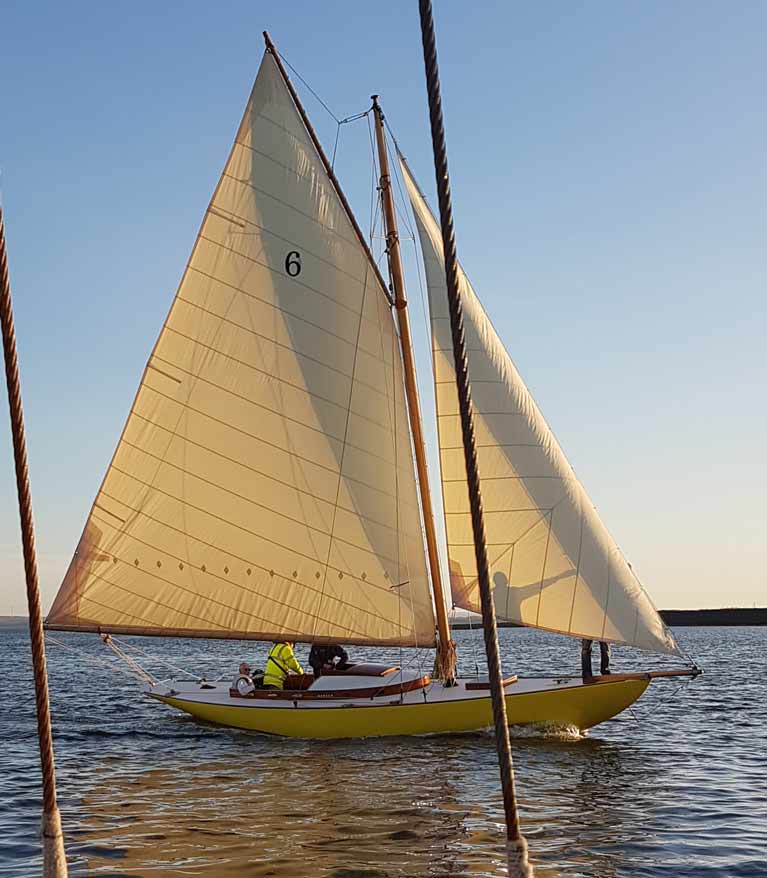 After the wettest and windiest Autumn in years, the first days of December brought ideal conditions for Naneen’s maiden sail. Photo: Kate Griffiths
After the wettest and windiest Autumn in years, the first days of December brought ideal conditions for Naneen’s maiden sail. Photo: Kate Griffiths
Everything works brilliantly! The Dyneema standing rigging (another embracing of modern materials) had been set up tight by Steve and Dan, and was just slightly slack on the lee side in an admittedly gentle wind. The breeze and late sunshine were just perfect, yielding astonishing colours – it reminded me of the time Peggy Bawn was in America, and that great photographer of classic yachts Benjamin Mendlowitz insisted we had a photo session in the evening light to make the most of Peggy’s many curves, and he was absolutely right.
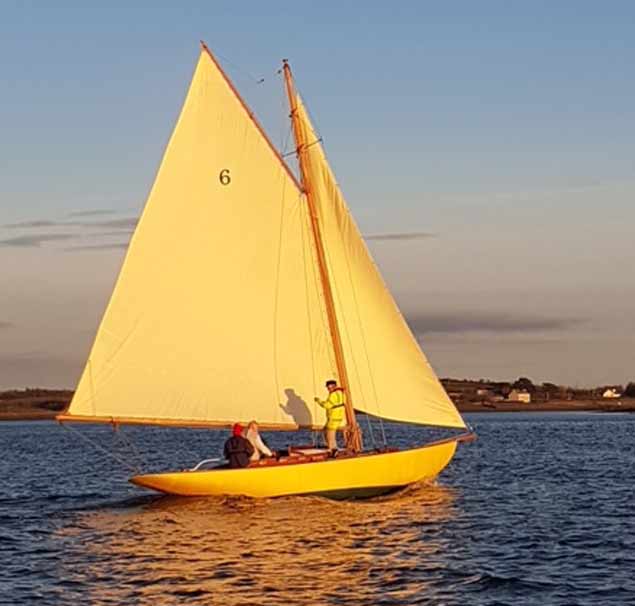 A magic weather window in December enabled the Shannon Estuary to provide a special image of the restored Naneen in classic Ben Mendlowitz style. Photo: Kate Griffiths
A magic weather window in December enabled the Shannon Estuary to provide a special image of the restored Naneen in classic Ben Mendlowitz style. Photo: Kate Griffiths
Naneen slipped along so effortlessly, leaving little wake, that at times it was all that Fintan could do to keep up with us with Sally O’Keeffe under power. Enchantment was total. All credit to the wonderful work of Steve Morris, Dan Mill, James Madigan, Fintan Carroll, and Kate Griffiths. And also Sue Pennison for the splendid rope and leatherwork, while on the day a special mention for Steve Hall of North Sea Sails of Tollesbury.”
 Key members of the Naneen restoration team at her launching at Kilrush in September included (left to right) Steve Morris, James Madigan, Hal Sisk, Fionan de Barrra, Fintan Ryan and Dan Mill. Photo: W M Nixon
Key members of the Naneen restoration team at her launching at Kilrush in September included (left to right) Steve Morris, James Madigan, Hal Sisk, Fionan de Barrra, Fintan Ryan and Dan Mill. Photo: W M Nixon
The new look for the Dublin Bay 21s makes us realise that in their original form, the huge rig was such an in-your-face feature that you scarcely noticed the remarkable and harmonious beauty of the hull and coachroof. But now with the simpler rig they’re there for full appreciation, and by next summer the first four restored boats should be in Dun Laoghaire and available for accessible sailing.
Their presence will fit well with the developing quest to provide a more meaningful interaction between town and harbour, but meanwhile, the growing size and vigour of the classic Dublin Bay Water Wag class is testament to the eternal attraction of wooden boats to time-honoured designs. For although today’s 14ft 3in Wags - as designed by Maimie Doyle in 1900 - may have seen as many as sixty boats built over the intervening 119 years, until recently there had always been a certain level of attrition, and when boats disappeared beyond trace, the class was scrupulous abut re-allocating their sail numbers to new boats, rather than allowing an artificial total to develop.
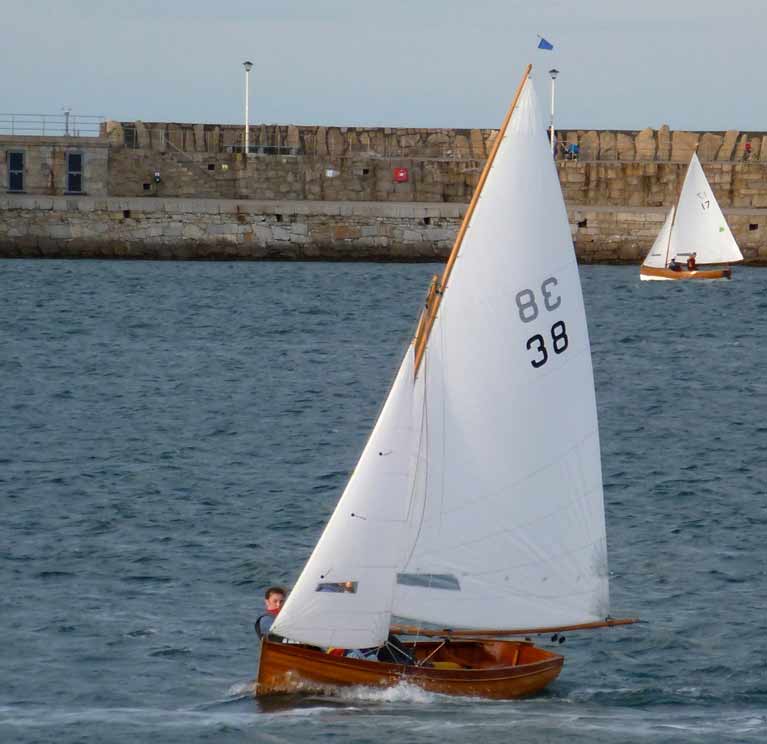 Guy Kilroy’s 2001-built Water Wag Swift in top racing trim. In 2020 the class – established in 1887 - will have more than fifty registered boats to the Maimie Doyle design of 1900. Photo: W M Nixon
Guy Kilroy’s 2001-built Water Wag Swift in top racing trim. In 2020 the class – established in 1887 - will have more than fifty registered boats to the Maimie Doyle design of 1900. Photo: W M Nixon
But 2020 will be special, as an officially registered Water Wag No 50 will be sailing for the first time ever, owned by Mandy Chambers and created under a Boat Building School scheme at the Albola yard in San Sebastian in the Basque region of Spain. There, another interesting project is the re-creation of a very ancient Basque whaler found in the St Lawrence river in Canada, which may be proof – were it needed – that enterprising Basque fishermen were well aware of the existence of North America before Columbus got there, but had kept it as a trade secret.
The reach of the vintage Irish one design classes has also extended across the Atlantic, as a Water Wag for David Espey and a Dublin Bay 24 are both being created in the Apprenticeshop in Rockland in Maine, while of course in France, Mike Newmeyer’s Skol ar Mor near the Morbihan has availed of the Water Wag, Shannon One Design and Howth 17 boat-building ambitions to keep school programmes busy, as has Paul Robert’s Les Ateliers de L’Enfer in Douarnenez, where Ian Malcolm organised the re-building of the fatally-damaged Howth 17 Anita under the classic boat principle that’s it’s a re-building of the same boat if you use the original ballast keel.
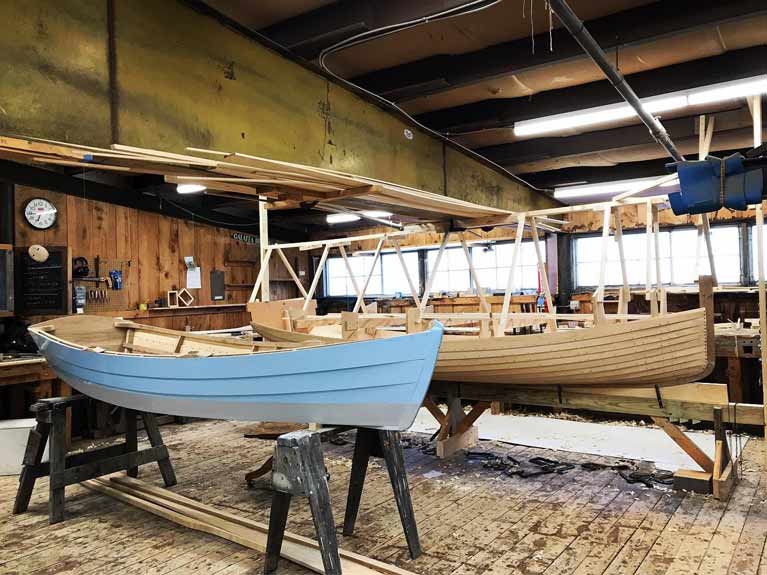 A new Water Wag for David Espey of Dun Laoghaire under construction (right) in the pleasant surroundings of the Apprenticeshop in Maine.
A new Water Wag for David Espey of Dun Laoghaire under construction (right) in the pleasant surroundings of the Apprenticeshop in Maine.
This utilisation of state-subsidised Boat Building Schools in France and Spain has been a Godsend for Ireland’s classics, but even though state support – if any – is extremely limited in this country and would be on a case-by-case basis through local authorities, it’s refreshing to find that craftsmen based in Ireland can rise to the challenge if given the chance.
Admittedly both Steve Morris and his expert team-mate Dan Mill of Galway hail from New Zealand, while Rui Ferreira down in Ballydehob – ace builder of Water Wags who is also currently putting a new deck on his second Howth 17 – is from Portugal. But the restoration of the Howth 17s to their pre-Storm Emma strength and better has found an encouraging level of traditional boat-building expertise hidden away in Leinster.
Brendan Tracy of Arklow – who worked on the restoration of Hal Sisk’s little 1884 Fife cutter Vagrant way back in 1984 – is still going strong, and after Storm Emma he put a new stem and other significant repairs into Michael and Jane Duffy’s Hera, one of the original five 1898 Howth 17s. And it was of course Larry Archer of Malahide, working in a shed out the back of the airport, who managed to find the time to restore Davy Jones and George Curley’s mega-damaged 1907-vintage Seventeen Rosemary, while at the same time making a very effective job of bringing Guy and Jacky Kilroy’s 25ft cutter Marguerite – built by Jack Wellington in Malahide in 1896 – up to a new standard of classic quality
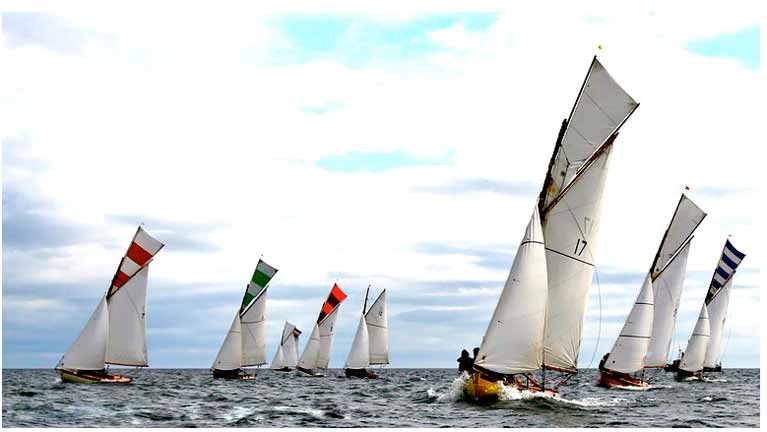 The 122-year-old Howth 17s marked the return to their full strength of 19 boats at their Annual Dinner and Prizegiving last weekend after successful restoration projects following the depredations of Storm Emma in March 2018. Photo: John Deane
The 122-year-old Howth 17s marked the return to their full strength of 19 boats at their Annual Dinner and Prizegiving last weekend after successful restoration projects following the depredations of Storm Emma in March 2018. Photo: John Deane
Inevitably links to West Cork seem to emerge wherever you turn in our classic and traditional boat-building, and there’ll often be someone from the widespread Leonard clan involved, as was seen when Gerry Levins and Mick Leonard in Portmarnock made good some fire damage on Shane O’Doherty’s Howth 17 Pauline. So with other wooden boatbuilders such as Tiernan Roe of Ballydehob adding to the talent pool, all roads seem ultimately to lead to Oldcourt on the Ilen River above Baltimore, where Liam Hegarty made such a masterful job of bring the 56ft 1926 ketch Ilen back to life, and the current project is the re-building of the one and only Saoirse.
But for now, the focus of attention is the re-born Naneen. Her luminous maiden sail in the early days of December means Christmas has come early for classic boat enthusiasts throughout Ireland.



























